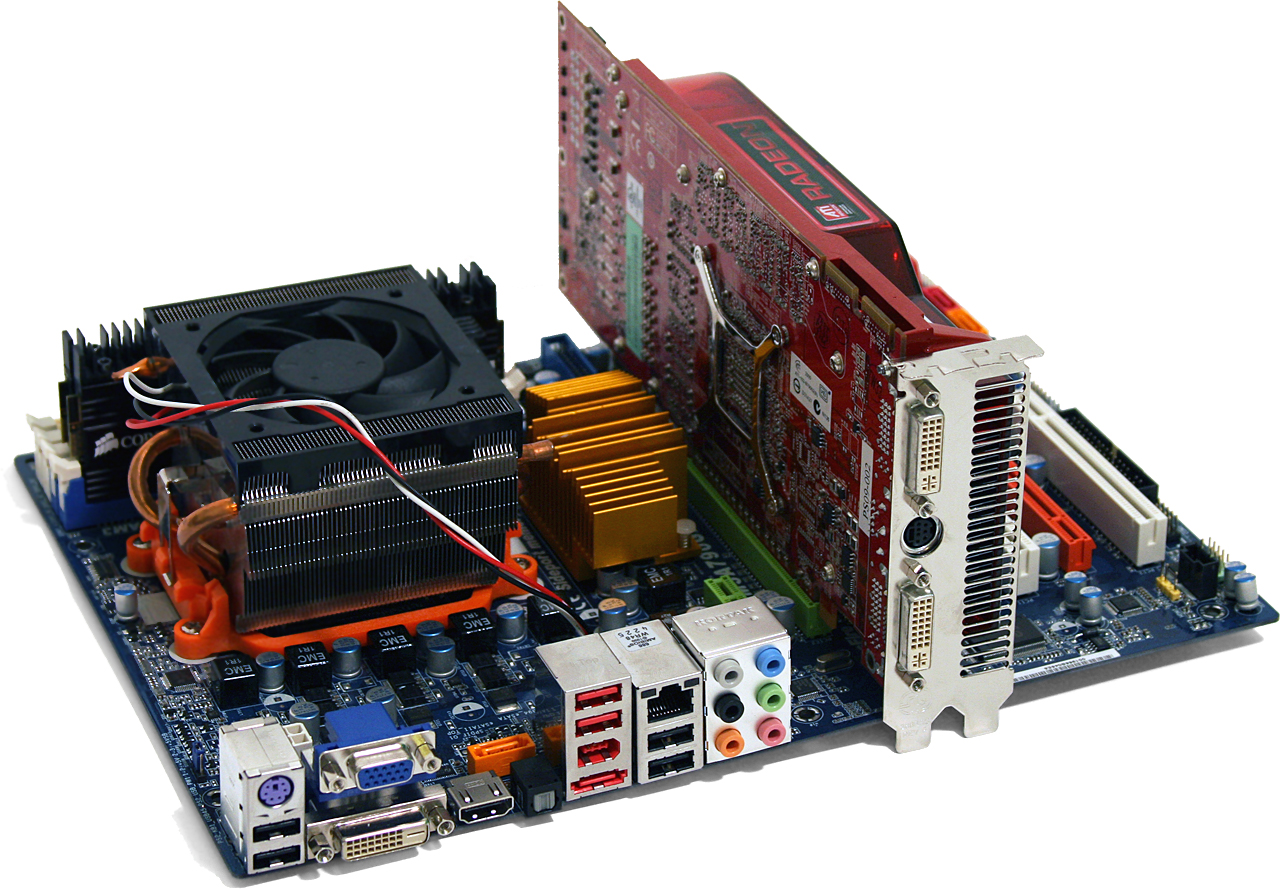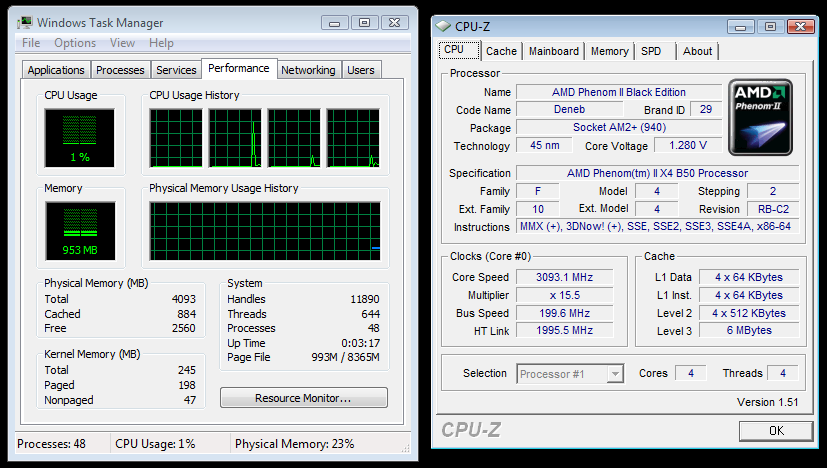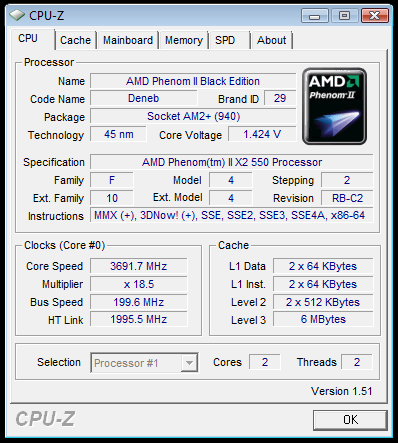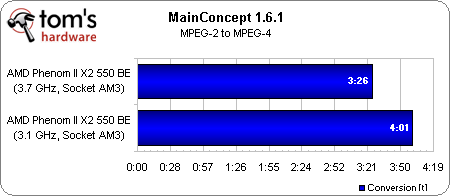AMD Athlon II X2 / Phenom II X2 And Low-Power CPU Bonanza
Overclocking, Unlocking, And Heart-Stopping
Let’s start with the most interesting news first.
You’re probably not going to believe this—I certainly didn’t at first—but whatever AMD was doing to turn off one core (yielding the Phenom II X3 700-series) or 2 MB of L3 cache (resulting in the Phenom II X4 800-series), it’s doing the same thing to turn Deneb cores into Phenom II X2 processors.
In order to test this, we set aside the Gigabyte MA770-UD3P motherboard used for the rest of our benchmarks (which didn’t have an SB750 southbridge, and thus no ACC) and dusted off the old ASRock M3A790GXH/128M board used to explore this same subject a couple of months back in Phenom II: Unlocking Cores, Cache, And A Free Lunch. We didn’t update its BIOS at first for fear of applying the microcode that’d undoubtedly render the undocumented feature unusable. Not surprisingly, the board didn’t recognize the CPU, but it still ran without an issue.
I hopped into its BIOS, set Advanced Clock Calibration to Auto, restarted, and was floored to see CPU-Z reporting all four of the chip’s cores fully functional.
Not believing my eyes, I ran our MainConcept benchmark and came back with a time of 2:09—almost half that of a Phenom II X2 550 running at 3.1 GHz (as you’ll see in a couple of pages). Remembering back to the hit-and-miss stability of our last exploration, I fired up Prime95 and let it run for a couple of hours. Though not completely thorough, the fact that the test came back with no errors was still a shock.
Then came the moment of truth. Could we update the ASRock board’s BIOS to 1.10, updated back in April with new microcode, and still enjoy four cores? Yes, in fact, we could. Although the board’s most recent BIOS version still isn’t able to recognize the processor with four cores turned on, we were able to update and continue using the chip as what amounted to something in between the Phenom II X4 940 and Phenom II X4 955 with Cool’n’Quiet support fully supported.
Of course, just because our sample unlocked without a problem doesn’t mean that all—or any—others will. Who’s to say how representative of retail hardware an AMD-supplied processor will be? Then again, would AMD seed easily-unlockable chips deliberately, only to put something different out for its customers? I have to suspect not. More than likely, these dual-core Phenom IIs don’t bin as X3s or X4s. Some enthusiasts will simply get lucky and end up with chips closer to that line. So long as motherboard vendors aren’t forced to lock the Phenom II X2s out, we’ll likely see scattered reports of folks experiencing some success unlocking their processors.
Get Tom's Hardware's best news and in-depth reviews, straight to your inbox.
The stakes are a little higher this time around, since we’re talking about turning a $100 CPU into a $220 CPU (averaging the 940 and 955 prices together). Back in the X3 720 days, you were looking at a $140 chip that might turn into a $190 model.
Kicking It Up
High off of our unlocking successes, it bothered us less that our Phenom II X2 550 wasn’t a particularly adept overclocker. With all four cores enabled, we were only able to push the 3.1 GHz chip up to 3.4 GHz before it petered out.
Once we disabled ACC, the ASRock board properly recognized the Phenom II X2 550 and we were on our way.
We managed to hit 3.8 GHz with it, but couldn’t lock in a voltage combination that’d run stably. Instead, we settled at 3.7 GHz and a fairly relaxed 1.4 V (Paul Henningsen was using settings as high as 1.55 V in his performance exploration yesterday).
There’s a definite performance improvement to be had from overclocking this CPU, but we’d much rather sacrifice the extra frequency for two additional cores at 3.1 GHz—especially in a test like MainConcept. While it’s true that you’ll get more speed in single-threaded apps by taking clock rate as high as possible, that’s of secondary importance given the speed-up in the apps optimized for threading.
Current page: Overclocking, Unlocking, And Heart-Stopping
Prev Page Low-Power Phenom IIs: Making HTPC Magic Next Page Test Setup And Benchmarks-
IronRyan21 Maybe if AMD would actually bring out some kind of nehalem competitor instead of flooding the cheapo market with variations of the same chips all over the place. There was Athlon 64 X2, brisbane and windsor, then there was Kuma, which was a phenom with 2 cores disabled. Now we got these new chips which are phenom 2s with 2 cores disabled. Lets put the money into some R&D and get somewhere. It seems like AMDs lost traction. sad.Reply -
thedipper IronRyan21Maybe if AMD would actually bring out some kind of nehalem competitor instead of flooding the cheapo market with variations of the same chips all over the place. There was Athlon 64 X2, brisbane and windsor, then there was Kuma, which was a phenom with 2 cores disabled. Now we got these new chips which are phenom 2s with 2 cores disabled. Lets put the money into some R&D and get somewhere. It seems like AMDs lost traction. sad.Reply
The low to mid-price segments are the best selling hardware categories.
Believe it or not, the $100 bang-for-the-buck graphics cards by far outsell the $500 space heater graphics cards. As with graphics cards, $50-100 CPUs by far outsell the $300-1300 CPUs.
The market that seems like most of the market - the enthusiasts and gamers - is actually not that much of the market share. Businesses building for performance-per-dollar, low-mid performance factory built home PCs, and people building web or media machines... these together outweigh the enthusiast/gamer market. -
jj463rd Those Phenom II 905e's and 705e's would be kickass if paired with the upcoming 785g motherboards.Reply
AMD has some new interesting CPU's. -
@IronRyan: Why not start your own semiconductor company and show AMD how it's done? Can a similar argument not be applied to Intel's "double cheeseburger" quads, and "single patty" dual-cores? If we even get any non-quad i7/i5s, do you know if Intel won't just do the same thing? In the future, instead of coming up with some lame argument, just post this for each article:Reply
"Hi, my name's IronRyan, and I like Intel. Go team Intel, yay!!!!!" -
deputc26 Anyone else see the Athlon X2 and think that if they underclocked and undervolted it they'd finally have a legitimate mobile contender?Reply
If they can run 4 cores at 2.5ghz and 8mb cache on 65w they should be able to run 2 cores at 2.5 ghz and 2mb cache at less than 32.5w. -
rdawise Interesting article...I'm glad you put this against the E6300. I haven't seen much about this chip. It as if Intel just snuck on onto the market. I wonder how high of an overclock you can get with it....Reply
Onto the article, it seems as if the Phenom II x2 550 BE would a great chip in a value gaming rig. If you could unclock the extra cores and get it stable, you'd be one lucky man. Can't wait till see these on the Egg... -
cangelini Quickest Pentium, only one with a 1066 MHz bus, disappointing that it's missing some functionality, though.Reply
Anyone else reminded of GeForce 2 MX when they see how Intel is positioning its mainstream chips these days? I'm all for differentiating with performance to drive down price (even cutting performance-oriented features, like Hyper-Threading), but don't start shedding the actual capabilities of an architecture to handicap it. -
I would find the Phenom X2 550 interesting because many of the programs I still run today are singlethreaded.Reply
These programs benefit more from a higher clockrate than more cores.
Keeping this in mind, and the fact that an OS doesn't (spectacularly) boot faster with more cores, I think the X2 is a great buy.
I'm a bit dissapointed at the powerdraw. For a HDTV box you don't necessarily need to buy a Radeon 4850. Perhaps a lower powerdraw (and price) in the 4770 or 4670 will be better.
To playback full HD (1080p) I suppose a Radeon HD 2900XT would be enough.
Add office tasks, internetting, some photoshop, and casual gaming on a 22"monitor (1680x1050 pix), and a Radeon 4670 would be enough in most cases.
If you have a 24" monitor (1920x1200 pix) a Radeon 4770 would do.
Only when latest gaming is concerned should you go for a Radeon 4870 or a 4890. -
cangelini Pro, for an HTPC, you'd be fine with a 4670, more than likely. The challenge will be building a system able to keep that setup cool enough. The Maui box with the 905e was *near-silent* but a discrete card would have wrecked this, and a 4670 is almost too much card to be passively-cooled (a la Ultimate-style) without better airflow in the case.Reply




